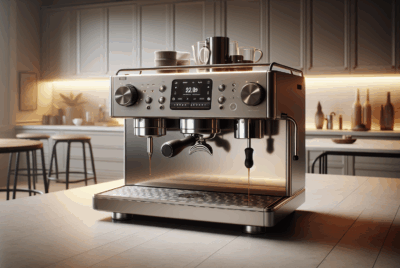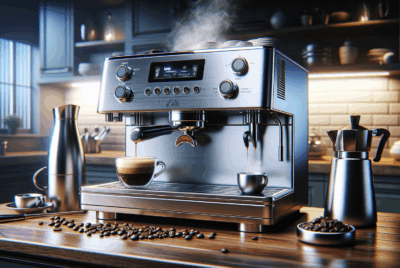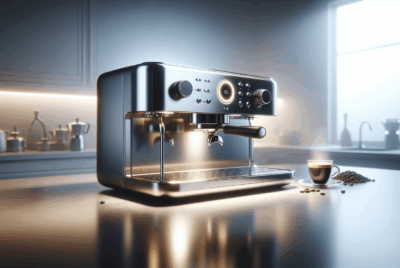How to Descale Breville Espresso Machine: Step-by-Step Guide
As an Amazon Associate, I earn from qualifying purchases, at no additional cost to you. Disclaimer
Owning a Breville espresso machine brings the joy of crafting delicious coffee at home. It’s important to look after it with regular maintenance.
This helps ensure it runs smoothly and makes great coffee every time.

I find that cleaning and descaling the machine regularly are key steps. To descale your Breville espresso machine, use a descaling solution and follow the machine’s instructions. This helps remove mineral buildup that can affect the taste and performance.
Taking a bit of time to clean and maintain the machine makes a big difference. It not only keeps the machine in good working order, but it also enhances your coffee experience.
Understanding the Importance of Descaling
Descaling your Breville espresso machine ensures that minerals don’t build up, which can affect taste and machine longevity.
Effects of Mineral Buildup
Mineral buildup, mostly from hard water, can cause real problems for espresso machines. I’ve seen how these minerals, mainly calcium and magnesium, cling to the machine parts.
This layer reduces water flow, affecting how your machine works.
When left unchecked, mineral deposits can make your espresso taste strange. Hard water deposits can even lead to blockages, causing the machine to overheat or break. Regular descaling can help avoid costly repairs by keeping these minerals from accumulating.
Improving Coffee Taste
I find that coffee taste can change drastically due to mineral buildup. Minerals can mix into the water and alter the flavor of your espresso.
With routine descaling, these unwanted tastes are cleared, allowing each cup to taste as it should.
Keeping your machine clean lets you enjoy the full flavor of your coffee beans. The water should flow smoothly, extracting the perfect flavors. When your espresso doesn’t taste right, it might be time to descale.
Extending Machine Lifespan
A big part of taking care of my espresso machine is making sure it lasts as long as possible. Regular descaling helps make that happen.
By removing mineral deposits, the machine doesn’t have to work as hard.
Machines that aren’t descaled can overheat, wear out, or break down frequently. Avoiding this trouble is simple with regular cleaning. Not only does it keep repairs down, but it also maintains efficient performance.
Preparing for Descaling
Before starting the descaling process, I make sure to have all the necessary items and choose the right descaling solution for my Breville espresso machine. Using proper supplies is important for a successful experience.
Gathering Necessary Supplies
I first collect all the items I’ll need. Here’s my checklist:
- Breville espresso machine: Make sure it’s unplugged and cooled down.
- Descaling solution or an alternative: I decide between a commercial product or a homemade remedy.
- Measuring cup: Helps with exact measurements.
- Soft cloth or sponge: Useful for wiping and cleaning components.
- Access to water: I usually have plenty of water nearby for rinsing parts.
Having everything ready saves me time and makes the process smoother.
Selecting a Descaling Solution
Choosing the right descaling solution is essential. I often consider the following options:
- Breville descaling solution: This is recommended by the manufacturer and ensures compatibility.
- White vinegar: A handy household item that can be mixed with water. I use one part vinegar to one part water.
- Citric acid: Another choice that is mixed with water, often preferred for being eco-friendly.
I always follow the instructions on any product I use to protect my machine.
The Descaling Process

When it’s time to descale my Breville espresso machine, I follow a clear process. This involves starting the descaling cycle, cleaning various machine components like the portafilter, and performing rinse cycles to ensure thorough cleaning.
Starting the Descaling Cycle
To begin, I fill the water tank with a descaling solution, following the instructions on the descaling product. I turn on the machine and place a container under the steam wand and spout.
Then, I start the descaling cycle by pressing the descaling button. This process pushes the solution through the system.
Next, I open the steam valve slightly, allowing some of the solution to pass through the steam wand. I make sure to close the valve once the cycle is complete. This part of the process usually takes about 20-30 minutes.
Cleaning the Machine Components
While the descaling cycle runs, I clean the portafilter and steam wand. I remove the portafilter and rinse it under warm water, ensuring no coffee grounds remain.
I also wipe the steam wand with a damp cloth to remove any milk residue that may have stuck.
For the drip tray, I remove it from the machine and wash it with warm soapy water. Proper cleaning of these parts ensures they work effectively and maintain the machine’s performance.
Rinsing the Machine
After the descaling cycle is complete, I empty and rinse the water tank. I fill it with fresh water to start the rinse cycle.
I run at least two rinse cycles to ensure all descaling solution is flushed out. This step is crucial to avoid any leftovers that could affect the coffee taste.
While rinsing, I also pay attention to the steam wand. I let some clean water pass through it to remove any remaining descaling solution. This helps keep the wand clear for frothing milk.
Drying and Reassembly
Once rinsing is done, I dry the water tank, the portafilter, and the drip tray using a clean towel. It’s important to ensure that these parts are completely dry before reassembling.
A damp cloth is enough for wiping the exterior of the machine.
Finally, I put all the components back in place. This includes reattaching the portafilter and placing the drip tray back in its spot. Now, my Breville espresso machine is ready to brew coffee again, free of any scale buildup.
Post-Descaling Steps

After descaling your Breville espresso machine, there are a few important steps to take. These will ensure the machine functions correctly and makes great coffee. I focus on checking the water flow and running a brew cycle.
Testing the Water Flow
Once descaling is complete, I start by examining the water flow. Turning on the machine, I run water through the system without adding any coffee grounds.
This step is crucial to eliminate any remaining descaling solution from the system.
Clean water should flow steadily from the group head and steam wand. If I notice any odd behavior or reduced flow, I repeat the rinsing process. I also take this opportunity to ensure there are no blockages. Even a small amount of residue can affect performance.
Performing a Brew Cycle
For the brew cycle, I use espresso beans to test the machine’s functionality. I measure and grind my beans, just as I would for a regular espresso shot.
This helps check if the machine operates properly post-descaling.
As I initiate the cycle, I pay attention to the performance. I look for smooth operation and consistent coffee extraction.
If there’s any issue, such as weak coffee or poor pressure, I know the machine might need another rinse or potential maintenance. This step ensures that my Breville espresso machine is ready to make delicious coffee again.
Regular Maintenance and Cleaning

Keeping a Breville espresso machine in top condition involves consistent cleaning and maintenance. This includes descaling regularly, replacing the water filter, and following a daily cleaning routine. Proper care prevents clogging and ensures high-quality coffee.
Frequency of Descaling
I descale my Breville espresso machine every three months. Descaling prevents mineral build-up that can cause clogging. If I use unfiltered water, I might need to descale more often.
Descaling solutions, specifically meant for espresso machines, are effective and safe. I always follow the instructions in the manual for the correct mixture and process.
Regular descaling helps maintain the machine’s efficiency and flavor consistency. I set reminders to ensure I never miss a descaling session. This keeps my espresso tasting fresh.
Replacing the Water Filter
I replace the water filter every two months to maintain the quality of water and prevent clogging. Using a fresh filter also minimizes mineral deposits.
The replacement process is simple and usually involves removing the old filter and inserting a new one.
Using filtered water extends the life of the machine. It reduces the frequency of descaling. If I notice the filter change indicator, I replace the filter promptly. This simple step is crucial for the machine’s longevity.
Daily Cleaning Routine
Every day, I clean my Breville espresso machine after use. This includes wiping down the exterior with a soft cleaning cloth. I also ensure the drip tray is emptied and cleaned to prevent any mold build-up.
I rinse the portafilter and baskets with warm water to remove coffee oils and grounds.
Paying attention to steam wands is important too since milk residue can clog them. Regular cleaning leads to better performance and taste. These daily habits make sure my machine runs smoothly and efficiently.
Troubleshooting Common Issues After Descaling

After descaling your Breville espresso machine, you might notice a few problems. Common issues include water not flowing properly or the machine not heating up. Here are some steps to help get everything running smoothly again.
Water Not Flowing Correctly
If water doesn’t flow as it should, check for clogs. Sometimes scale buildup remains and causes blockages. I usually start by examining the water tank.
Make sure it’s seated properly and the filter is clean.
Next, inspect the group head and portafilter. Residual scale or coffee grounds can block flow. Use a pin or needle to clear any obstructions.
For Barista Pro and Barista Touch, follow the user manual to access and clean these parts.
If the problem persists, run another descaling cycle. Use a descaling solution rather than homemade mixes, as it is more effective. Always rinse thoroughly after descaling to avoid residue buildup.
Machine Not Heating
If the machine doesn’t heat up, the heating element might be the culprit. First, unplug the machine for safety.
Inspect connections for any loose or damaged wires. Be sure to check the thermostat settings, as incorrect settings can cause heating issues.
For the Barista Pro model, ensure the temperature settings are correct. An online troubleshooting guide from Breville can provide valuable insights into specific model issues.
If you’re using a Barista Touch, you might want to reset the machine to its factory settings.
In case heating problems continue, contact Breville customer support for professional assistance. It’s crucial to address heating issues promptly to prevent further damage to your coffee maker.
Alternatives to Commercial Descaling Solutions
When it’s time to descale my Breville espresso machine, I like to use eco-friendly methods. These alternatives can involve everyday items like vinegar and baking soda, helping me maintain my machine without relying on commercial descaling solutions.
Using Vinegar as a Natural Descaler
Vinegar is an effective and natural choice for descaling. White vinegar is best for this task.
It’s important to mix equal parts of water and vinegar. I pour the mixture into the water tank of the espresso machine.
Then, I run a brew cycle without coffee. This helps to clean out the internal parts where scale builds up.
After the cycle, I rinse the machine by running two cycles with plain water. This ensures no vinegar taste remains.
The acidity in vinegar helps break down the calcium and mineral deposits. It’s a straightforward method and makes use of a common household item.
It’s not only cost-effective but also gentle on the machine compared to some harsher chemicals.
Creating Homemade Descaling Mixtures
Another option is to create a homemade descaling mixture using ingredients from my kitchen. A popular mix is a solution of baking soda and water.
I use about a tablespoon of baking soda in a liter of water. Stir the solution until the baking soda dissolves completely.
I fill the machine’s water tank with this mixture and run a brew cycle. Let it fully cycle through to remove any scale buildup.
Afterward, I rinse the espresso machine with two full cycles of plain water. This step is crucial to remove any leftover baking soda particles.
Using baking soda is eco-friendly and an excellent soda-based option for maintaining the machine.
Frequently Asked Questions
In this section, I answer common questions about descaling a Breville espresso machine. I share how often you should descale and whether vinegar is an option. I also cover using Breville’s descaler compared to alternatives.
How often should I descale my Breville espresso machine?
I recommend descaling the machine every 2-3 months. Regular descaling keeps the machine running smoothly and prevents build-up.
This can vary if you have hard water, so you might need to descale more often.
What are the steps to descale a Breville Barista Express?
To descale a Barista Express, start by emptying the water tank.
Fill it with a descaling solution and water. Run the solution through the machine using the cleaning cycle. Rinse with fresh water after. Follow the machine’s manual for detailed steps.
Can vinegar be used as a descaling agent for Breville coffee machines?
I suggest caution with vinegar. While some users try it, Breville recommends using their own descaling solutions.
Vinegar could affect the taste of your coffee and might not be as effective. Always test on a small scale first if you decide to use it.
Is it necessary to use the Breville brand descaler for their machines, or are there alternatives?
You don’t have to use Breville’s descaler. There are other reliable brands available.
However, using Breville’s can ensure compatibility and effectiveness. If you choose an alternative, make sure it’s suitable for espresso machines.
What is the process for descaling a Breville Bambino espresso machine?
For the Bambino, I suggest removing the drip tray and filling the water tank with descaling solution and water.
Start the descaling cycle as indicated in the manual. Flush with clean water when complete. Always refer to the Breville guide for precise instructions.
Are there specific instructions for using descaling tablets with Breville espresso machines?
Using descaling tablets is easy. Dissolve the tablet in water and pour it into the tank. Run the mixture through the machine. Make sure to follow the machine’s specific instructions for this process. Tablets can offer a simple way to maintain your espresso machine.



